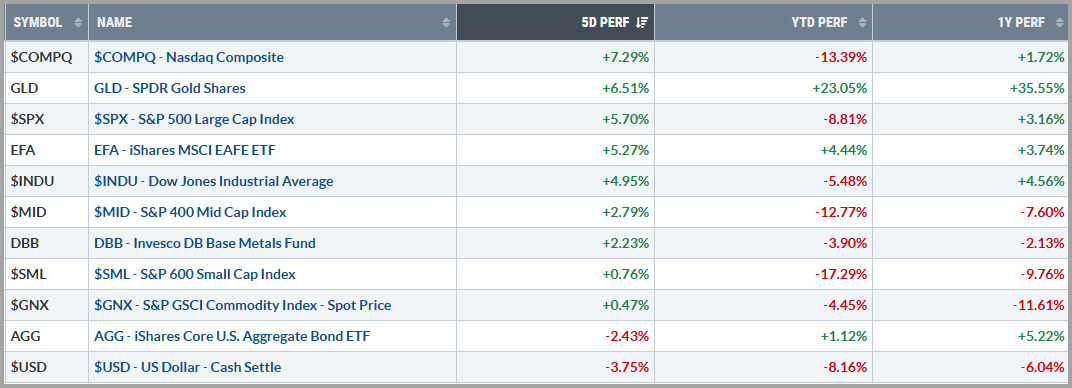Market Wrap-Up: A Volatile Week Ends on a High Note
After one of the most volatile weeks in recent memory, stocks managed to end the week in the green. While headlines were dominated by tariff news, easing inflation concerns and solid earnings estimates gave investors something to cheer about.
Once the dust settled, the S&P 500 Index finished up 5.70% for the week, while the Nasdaq Composite closed 7.29% higher. The Dow Jones Industrial Average put up nearly 5% for the week, while the small cap Russell 2000 Index lagged, but still posted a 1.82% gain.
With all the craziness, 10-year treasury yields spiked nearly ½ of a percent to well over 4.5% by Friday morning, after ending the prior week under 4% and the US Dollar fell by nearly 3% to new cycle lows. Gold ended last week with a gain of 6.51% to close out Friday at all-time highs. Crude oil extended recent declines last week, but notably ended well off the week’s multi-year lows, while economically sensitive copper futures bounced off multi-month lows to eventually close out the week on a positive note.

Source: stockcharts.com
Tariffs Take Center Stage
Trade tensions are still front and center. The U.S. has hit China with steep tariffs, some products are facing levies as high as 145%, with others around 125%. China has responded in kind, though they’ve said their tariffs will be capped at 125%. Time will tell if that holds. On the bright side, both the U.S. and China say they’re open to negotiations and over the weekend, the Trump administration offered some relief to tech companies by exempting key items like smartphones, semiconductors, and solar cells from the new round of tariffs.
Markets also breathed a sigh of relief from last week’s inflation data. Both the Producer Price Index (PPI) and Consumer Price Index (CPI) came in lower than expected. Core inflation, which excludes volatile items such as food and energy, cooled as well. After the strong jobs report from the week before, this easing in inflation is helping ease some stagflation/recession worries as it gives the Fed more breathing room to cut rates should the economic backdrop deteriorate.
The Week Ahead:
This week’s economic data will give investors their first real look at how the reciprocal tariffs may be impacting the U.S. economy. Key manufacturing surveys, the Empire State Index (Tuesday) and Philly Fed (Thursday), will provide early clues as to whether tariffs are already hitting growth. Meanwhile, Wednesday’s Retail Sales report will show if consumer spending was already slowing before the latest tariff headlines. With recession and stagflation worries on the rise recently, markets will be watching closely. Stronger-than-expected data could ease those concerns and help support stocks, while weak numbers may trigger renewed selling. One would also expect tariff-related news to continue to impact trading.
Tying it all together:
Uncertainty has been driving the markets lately as investors seemingly fear the new administration’s tariff policies and potential trade wars could induce a recession, despite the fact that hard economic data remains largely firm. Last week, the S&P 500 technically entered “Bear Market” territory having slid over -20% from its recent highs.
Last week I wrote:
“These tariffs, introduced via executive order, have sparked uncertainty around trade policy and corporate profitability. However, they’re not set in stone. Because they were enacted without legislation, they can be rolled back just as quickly, especially with growing political pressure ahead of the mid-term elections. In short, this doesn’t have to be a permanent path.
Most critically, the market may have already priced in the worst-case tariff scenario. That removes some of the uncertainty from the equation. Any indication that these policies could be softened or reversed might be enough to spark a rebound. While short-term volatility is still in play, even modest positive news could be a welcome catalyst.”
With Trump’s announcement of a 90-day pause on new tariffs, markets staged a historic rally, closing the week more than 11% above recent lows. The rebound reinforced the idea of a “Trump Put”, the belief that policy shifts will be used to support markets when pressure builds. This move could help lift investor sentiment, and when paired with solid economic data and a strong earnings season, it may give markets the ingredients they need to find more stable footing.
So far, defensive sectors, value stocks, and low-volatility names have held up relatively well. At the same time, maintaining diversification and strategically overweighting safe havens like bonds and precious metals has provided added comfort to stay the course. While we are certainly not out of the woods just yet, but a glimmer of hope has emerged.
Market downturns, such as the current one, have historically presented opportunities for long-term investors. These periods may allow for acquiring assets at more favorable valuations and securing stronger portfolio yields. It’s important to maintain a long-term perspective while exercising patience, vigilance, and diversification. Historically, these market conditions have tended to be short-lived, often rewarding those who remain focused on their long-term investment goals.
Please feel free to share these commentaries and, should you have any questions regarding your current strategy or the markets in general, please reach out to your CIAS Investment Adviser Representative.
Securities offered through Capital Investment Group, Inc. & Capital Investment Brokerage, Inc.
100 East Six Forks Road; Raleigh, North Carolina 27609
Members FINRA and SIPC

